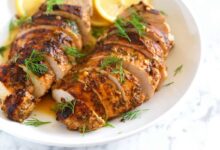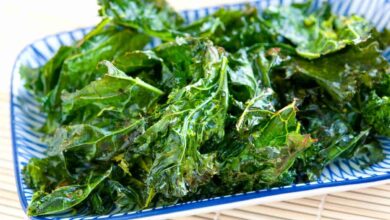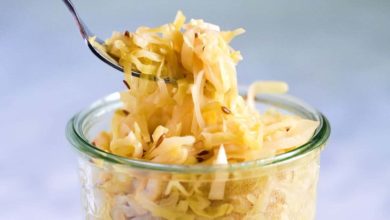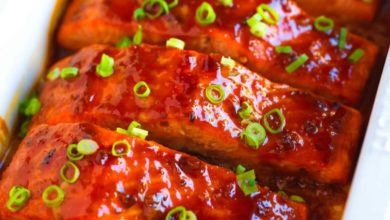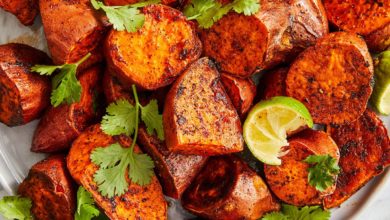Say hello to our new favorite turkey brine! For turkey with amazing flavor, soft and tender meat, and crispy skin, try our turkey brine recipe. We highly recommend it to anyone preparing a turkey.
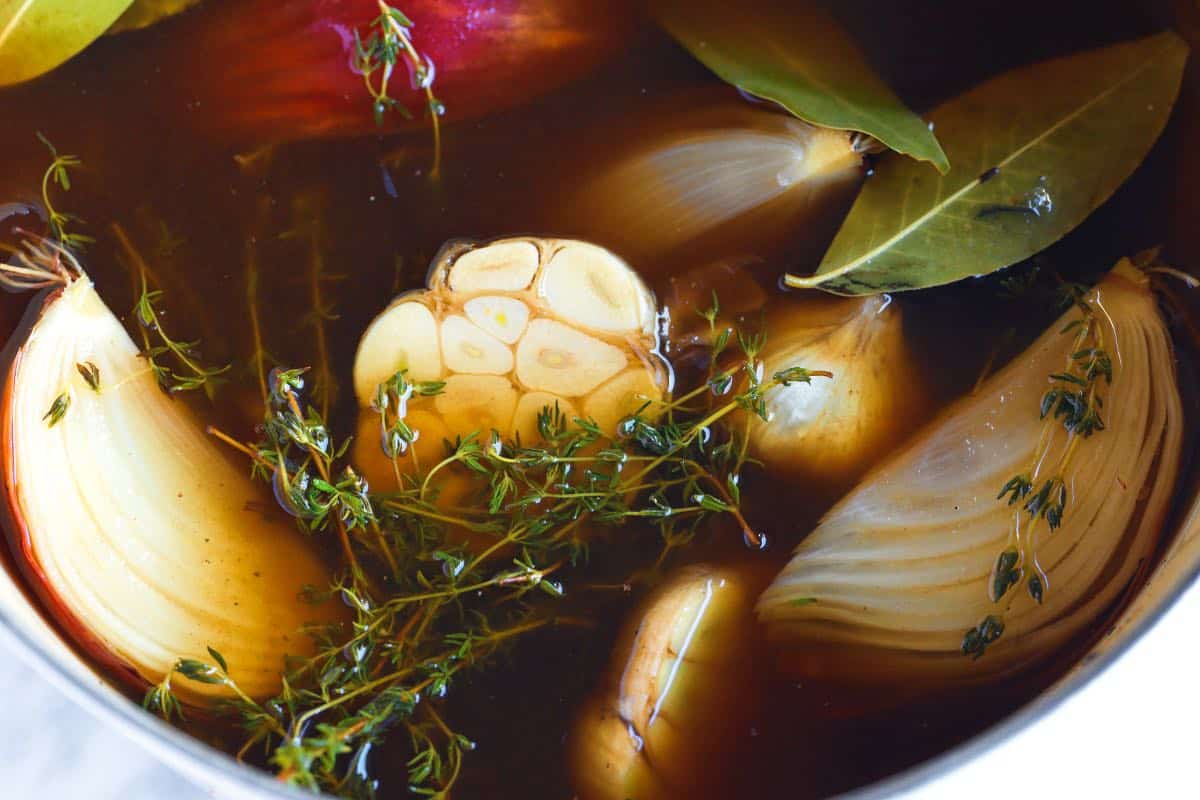
Related: See our ultimate roasted turkey with homemade gravy (recipe coming soon!)
Why We Brine Turkey
Before roasting turkey, we submerge it in a light brine for two days. The brine infuses our turkey with savory, delicious flavor, all while tenderizing the meat.
The salt and sugar brine pulls some liquid from the turkey meat and replaces it with the brine. We’ve also noticed that the turkey skin has a better texture after brining.
Our turkey brine = more flavor and better texture.
The Best Salt to Use
When brining, we use kosher salt. Avoid using iodized salt, as it can give the turkey a metallic taste. When measuring salt for your brine, use a scale or use our specific volume measurements in the recipe below (we have provided them for Morton’s and Diamond Crystal). In the photo below, both bowls are holding 4.5 ounces of salt.
You can see that the amount of salt looks less in the bowl in front of Morton. Diamond Crystal salt flakes are fluffier/bigger, so they take up more space. You don’t need to worry about this if weighing your salt, but if you use volume measurements (cups/tablespoons), it’s essential to know about it.
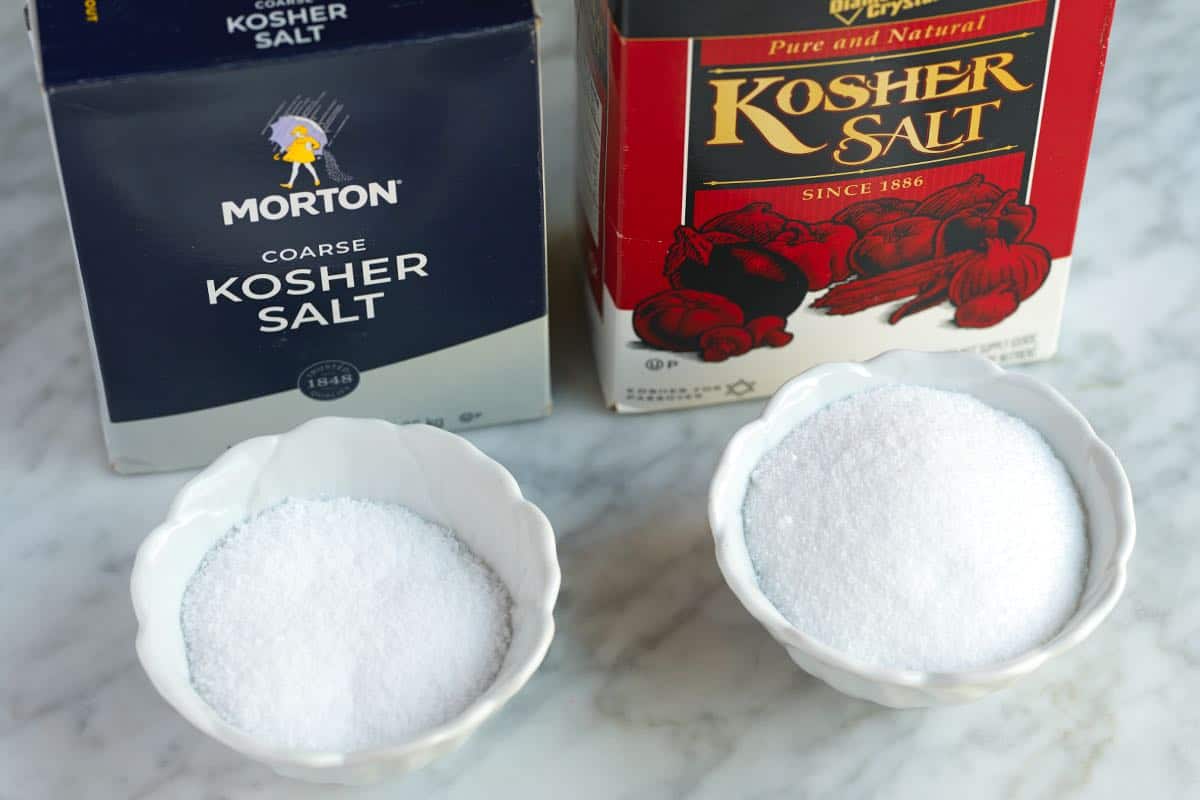
How Long to Brine
For the best results, we brine turkey for two days. Turkeys are large, and the brine needs time to work through the bird. If you do not have two days, we still recommend brining — just one day in this brine will produce a more flavorful turkey than none.
What to Add to Turkey Brine
We worked with our friend, Chef Richard Hattaway, on our turkey brine recipe and could not be more happy with the results. In our brine, we combine kosher salt with brown sugar, an onion, garlic, fresh thyme, bay leaves, Worcestershire sauce, and black pepper.
I was a stickler in making sure that brining our turkey was worth it and taste-tested the turkey meat closest to the carcass to check. This meat never touched any herbs or butter spread onto the outside of the turkey before roasting, and it still tasted wonderful. The aromatics and seasoning of the brine absolutely come through.
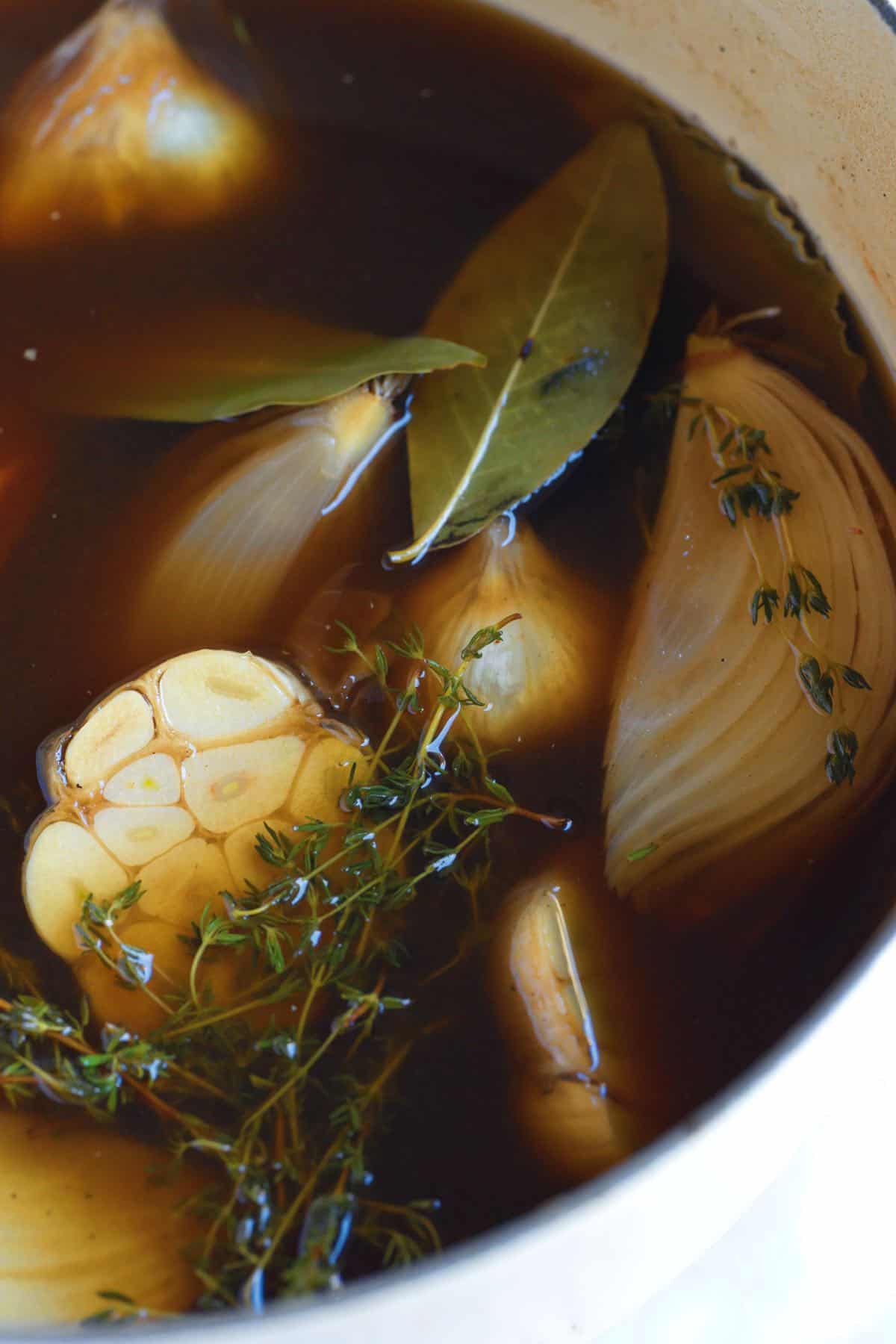
Where to Brine
I use a large heavy-duty brine bag, which is sold in kitchen stores and online. You can also use a 5-gallon bucket with a food-safe liner. To safely brine turkey, store it in temperatures at or below 40°F (4°C).
If you have the space (or a second fridge), you can brine turkey in your refrigerator — place your bag or bucket into the fridge.
If you do not have enough space, use a brine bag and place it in a well-insulated, ice-filled cooler. If you use a cooler, check the temperature of the ice water regularly to ensure that it stays below 40°F (4°C).
Don’t Worry About Rinsing the Turkey
Some brine recipes call for rinsing turkey after brining, but in the case of this recipe, there is no need. We have taste-tested rinsed and unrinsed turkey that sat in our brine and found no reason for it. The turkey will not be over-salted, promise.
Extra Tip: Air-dry the Turkey Overnight
For the crisp textured skin, air-dry your brined turkey in the fridge overnight. To do it, set the turkey on a roasting rack and then put it into a roasting pan or rimmed baking sheet.
I love this step because my brine is out of the way, and my turkey is brined and ready to roast the next day.
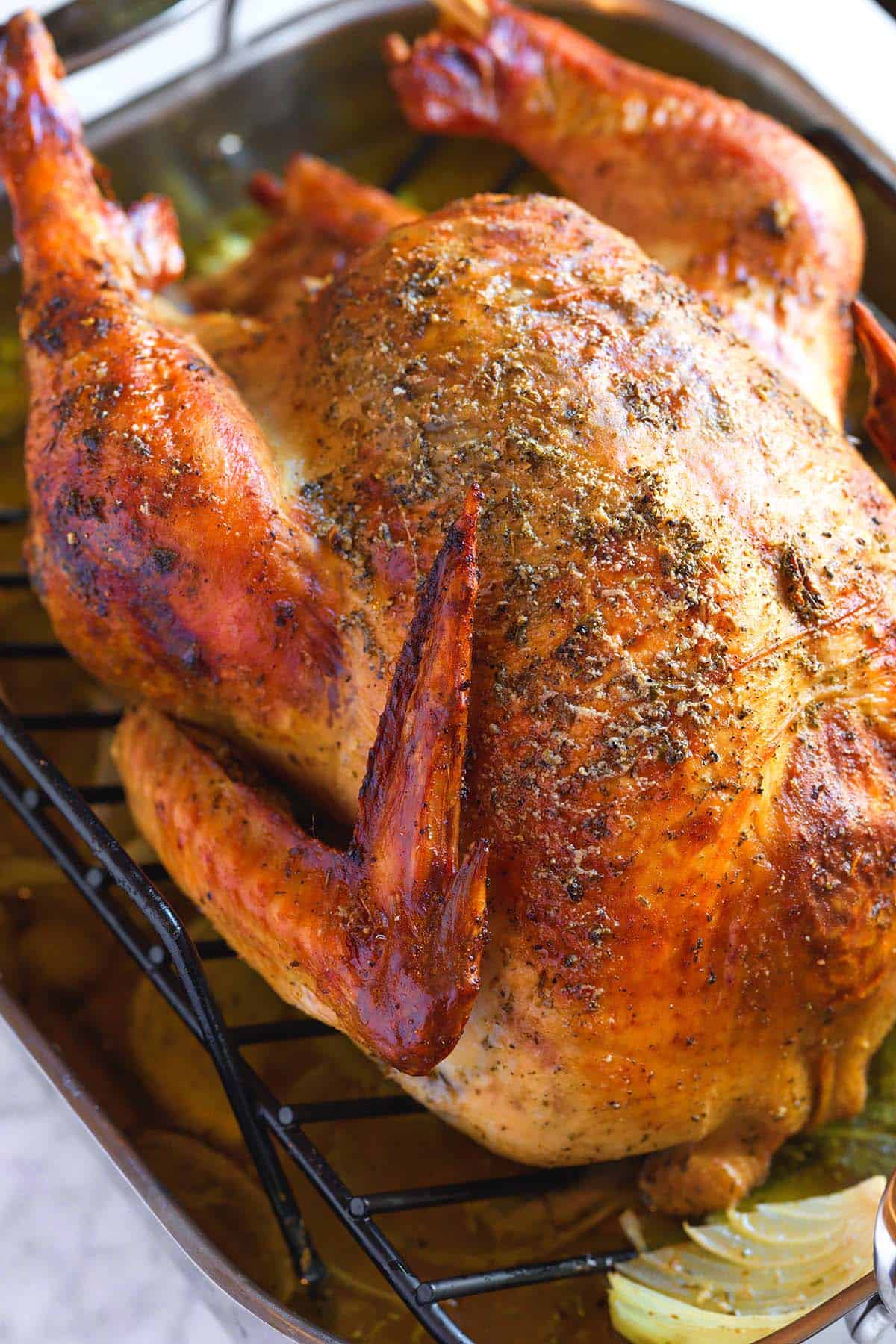
Thanksgiving Turkey Timeline
If you are like us, you don’t roast many turkeys throughout the year. Most of us really only roast them around the holiday season.
Here’s our timeline for thawing, brining, and roasting turkey. I will use Thursday as our goal since that’s how Thanksgiving falls in the US, but you can easily move the days around to fit your intended roasting day.
This timeline assumes a thawed turkey. To safely thaw a turkey, do it in the refrigerator. Plan on 24 hours in the fridge for every four to five pounds of turkey–so a 16-pound turkey will take four days to thaw.
- Monday: Brine the turkey
- Wednesday night: Remove turkey from brine, place it onto a rack set inside a roasting pan or rimmed sheet pan, and refrigerate overnight
- Thursday: Roast the turkey, allowing approximately 14 minutes per pound, in an oven preheated to 325°F (162° C). Here’s our recipe for roasted turkey (recipe coming soon!)
Turkey Brine (Amazing Flavor!)
-
PREP
-
COOK
-
TOTAL
Use this turkey brine for turkey with amazing flavor, soft and tender meat, and crispy skin. We highly recommend it to anyone preparing a turkey.
2 gallons, up to 20-pound turkey
You Will Need
1 (12 to 20 pound) turkey, thawed
2 gallons (7.5 L) cold water
4.5 ounces (128 grams) kosher salt; see tips for volume measurements
3/4 cup (160 grams) packed brown sugar
1/4 cup (60 ml) Worcestershire sauce or Pickapeppa sauce
4 teaspoons (10 grams) coarse ground black pepper
1 onion, quartered
2 whole bulbs garlic, cut in half
1 bunch fresh thyme
5 bay leaves
Directions
- Make the Brine
1In a large pot, combine 2 quarts (8 cups) of water, salt, brown sugar, Worcestershire sauce, black pepper, onion quarters, garlic, thyme, and bay leaves.
2Bring to a simmer over medium-high heat and cook for 5 to 10 minutes or until the salt and sugar have dissolved completely.
3Allow the brine to cool to room temperature.
- Brine the Turkey
1Place the turkey in a lined 5-gallon bucket or brine bag.
2Pour the room-temperature brine over the turkey, then add the remaining 6 quarts (24 cups) of cold water to the bucket or brine bag. If using a brine bag, be careful to hold the sides of your bag so they don’t flop down as you pour — another set of hands from a friend is very helpful.
3Remove as much air as possible from the liner or bag and secure it shut. Place the bucket or brine bag in the refrigerator or ice-filled cooler.
4Brine the turkey for two days. To ensure that all areas of the turkey are brined, flip it halfway through the two-day brine — allowing any areas not entirely submerged to soak in the brine.
- Air-dry the Turkey
1Remove the turkey from the brine and place it onto a roasting rack set inside a rimmed baking sheet or roasting pan. Do not rinse the turkey.
2Refrigerate overnight before roasting the next day. We roast turkey in an oven preheated to 325°F (162° C) and highly recommend roasting the turkey with our turkey butter.
Adam and Joanne’s Tips
- Salt: Diamond Crystal salt flakes are fluffier and lighter than Morton’s kosher salt. For Diamond Crystal kosher salt: use ¾ cup + ½ tablespoon. For Morton’s kosher salt: use ⅓ cup + 2 ½ tablespoons.
- Brine bag: Place in a roasting pan to prevent spills. We recommend using a heavy-duty brine bag.
- Cooler: Check ice water temperature regularly to ensure it stays below 40°F (4°C).
- Crisp skin: For best results, air-dry the brined turkey overnight in the fridge. If you are out of time, pat dry before roasting.




